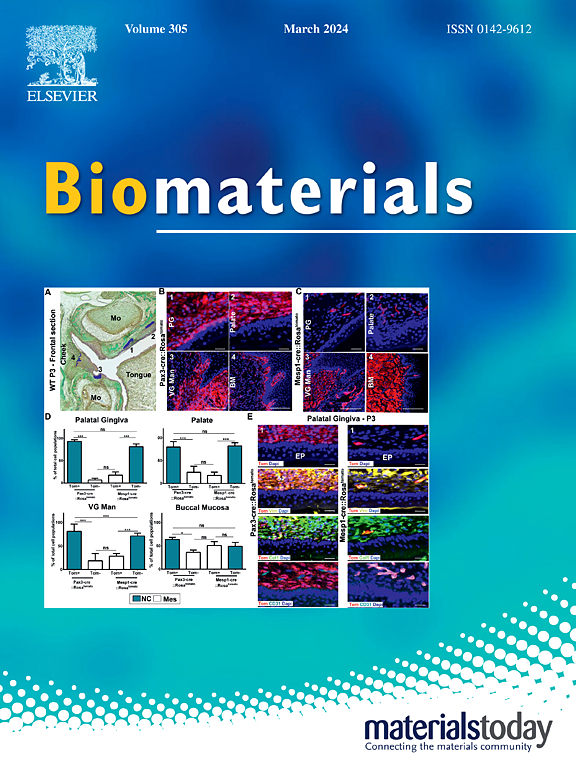Micro-/nanomotors as platforms for gas therapy
IF 12.9
1区 医学
Q1 ENGINEERING, BIOMEDICAL
引用次数: 0
Abstract
Active delivery of therapeutic gases for disease intervention is an appealing but challenging task that requires breakthroughs in nanomaterial-based delivery systems. Micro-/nanomotors (MNMs) capable of efficiently converting diverse forms of energy into mechanical motion have inspired innovations in the gas delivery and therapy domains, offering an alternative possibility to address the challenges of targeted delivery and controlled gas release during therapy. This review thus comprehensively summarizes recent advances in employing MNMs as mobile platforms for precise gas delivery and therapy. The review begins with an introduction of the physiological functions of diverse therapeutic gases, including NO, H2S, CO, O2, and H2. Then various proof-of-concept designs of artificial MNMs that can efficient propulsion in complex biological environments and intelligently release these gases in response to intrinsic or extrinsic stimuli are discussed. Particular emphasis has been placed on their potential in microenvironment modulation for disease treatment, aiming to demonstrate the distinct superiority of MNMs in this area. In addition, the key challenges and limitations of current MNMs utilized for gas therapy are addressed. It is believed that in the near future, MNMs will become sophisticated delivery platforms for facilitating gas therapy.

微/纳米马达作为气体治疗的平台
主动输送用于疾病干预的治疗气体是一项有吸引力但具有挑战性的任务,需要在基于纳米材料的输送系统方面取得突破。微/纳米马达(MNMs)能够有效地将各种形式的能量转化为机械运动,激发了气体输送和治疗领域的创新,为解决治疗过程中靶向输送和控制气体释放的挑战提供了另一种可能性。因此,本综述全面总结了利用纳米颗粒作为精确气体输送和治疗的移动平台的最新进展。本文首先介绍了不同治疗气体的生理功能,包括NO、H2S、CO、O2和H2。然后讨论了各种概念验证设计,这些设计可以在复杂的生物环境中有效推进并根据内在或外在刺激智能释放这些气体。特别强调的是它们在微环境调节疾病治疗方面的潜力,旨在证明纳米颗粒在这一领域的独特优势。此外,还讨论了目前用于气体治疗的MNMs的主要挑战和局限性。相信在不久的将来,纳米颗粒将成为促进气体治疗的复杂输送平台。
本文章由计算机程序翻译,如有差异,请以英文原文为准。
求助全文
约1分钟内获得全文
求助全文
来源期刊

Biomaterials
工程技术-材料科学:生物材料
CiteScore
26.00
自引率
2.90%
发文量
565
审稿时长
46 days
期刊介绍:
Biomaterials is an international journal covering the science and clinical application of biomaterials. A biomaterial is now defined as a substance that has been engineered to take a form which, alone or as part of a complex system, is used to direct, by control of interactions with components of living systems, the course of any therapeutic or diagnostic procedure. It is the aim of the journal to provide a peer-reviewed forum for the publication of original papers and authoritative review and opinion papers dealing with the most important issues facing the use of biomaterials in clinical practice. The scope of the journal covers the wide range of physical, biological and chemical sciences that underpin the design of biomaterials and the clinical disciplines in which they are used. These sciences include polymer synthesis and characterization, drug and gene vector design, the biology of the host response, immunology and toxicology and self assembly at the nanoscale. Clinical applications include the therapies of medical technology and regenerative medicine in all clinical disciplines, and diagnostic systems that reply on innovative contrast and sensing agents. The journal is relevant to areas such as cancer diagnosis and therapy, implantable devices, drug delivery systems, gene vectors, bionanotechnology and tissue engineering.
 求助内容:
求助内容: 应助结果提醒方式:
应助结果提醒方式:


